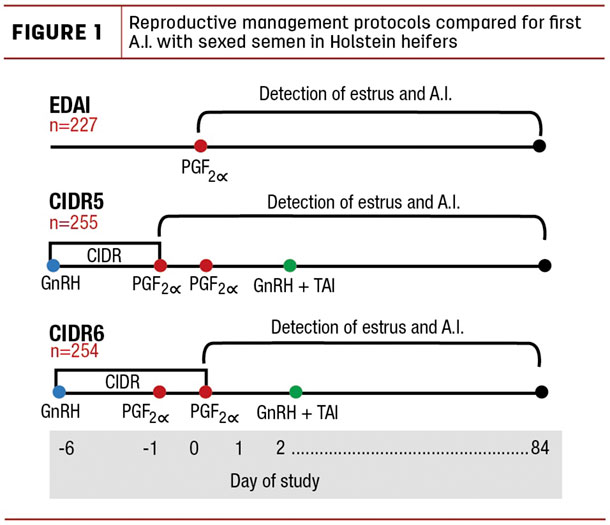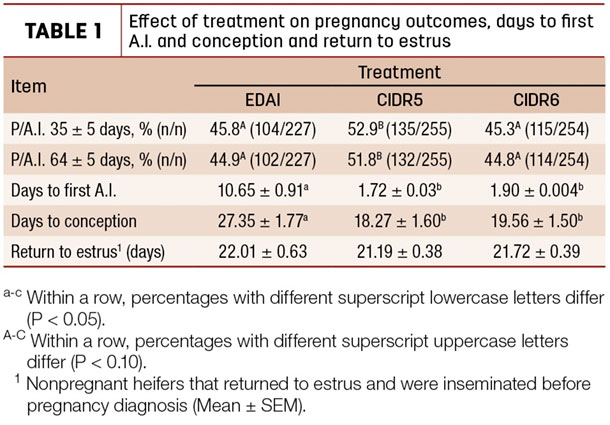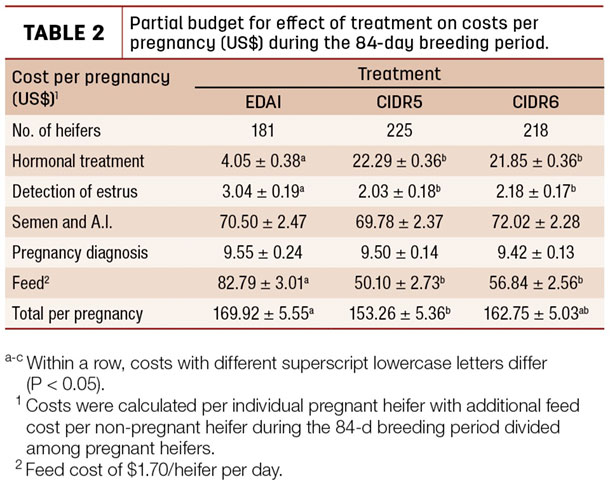A recent University of Wisconsin study shows the potential for greater fertility to sexed semen and improved reproductive efficiency in heifers with a specific synchronization protocol.
Synchronization protocols for timed artificial insemination (TAI) are commonly used for aggressive reproductive management of lactating dairy cows. By contrast, 69% of heifers in the U.S. are inseminated at first service based on once-daily detection of estrus. Currently, the recommended synchronization protocol for TAI in heifers is a five-day CIDR-Synch protocol, which yields similar pregnancies per A.I. to heifers inseminated after estrus when using conventional semen.
A limitation of the five-day CIDR-Synch protocol is: Approximately 30% of heifers are detected in estrus before scheduled TAI. This results in a protocol that is split between detection of estrus and TAI rather than allowing for the convenience of 100% TAI. In a preliminary study from our lab group, delaying removal of a progesterone insert by 24 hours until the second PGF2-alpha treatment of the five-day CIDR-Synch protocol decreased early expression of estrus before TAI to 1% with pregnancies per A.I. of 54% with conventional semen.
Despite increased adoption of sexed semen and modifications to the sexing process, pregnancies per A.I. with sexed semen are only 70% to 90% of conventional semen. In several studies, this reduction in fertility is even greater with heifers inseminated with sexed semen after a detected estrus yielding pregnancies per A.I. of 55% or less of conventional semen. Thus, an opportunity exists not only to increase fertility with sexed semen but also to increase reproductive efficiency of heifers.
Raising replacement heifers is a large investment for farmers, with the total cost of raising a replacement heifer from birth to calving of approximately $2,500. Of this total rearing cost, feed costs account for approximately 50%. Efficient reproductive management of heifers decreases days to first A.I. and conception, thereby decreasing days on feed and total rearing costs.
Plans for first A.I.
We conducted a study in collaboration with three farms in Wisconsin to compare Holstein heifers submitted to three reproductive management programs for first A.I. with sexed semen based on expression of estrus, pregnancy outcomes and the cost per pregnancy. Our objectives were to determine the effect of delaying CIDR removal by 24 hours on expression of estrus and pregnancies per A.I., compare TAI and once-daily detection of estrus (EDAI) for first-service pregnancies per A.I. and days to A.I. and conception, and compare the cost per pregnancy during an 84-day breeding period.
For first service, 736 Holstein heifers approximately 13 months old were randomized to one of three treatments for A.I. with sexed semen: a five-day CIDR-Synch protocol, a modified CIDR-Synch protocol with CIDR removal delayed by 24 hours or treatment with PGF2-alpha and once-daily detection of estrus and A.I. (Figure 1).

CIDR-Synch heifers received GnRH treatment and insertion of a CIDR on day -6. Then CIDR-Synch heifers received PGF2-alpha treatments five and six days (day -1 and day zero) later with CIDR removal either on day -1 (CIDR5) or day zero (CIDR6). After CIDR removal, CIDR5 and CIDR6 heifers were detected for estrus once daily after feeding via rubbed tail chalk. Control heifers on day zero received PGF2-alpha treatment and once-daily detection of estrus and A.I. with sexed semen (EDAI). Heifers were eligible for insemination on day one of the protocols, and CIDR5 and CIDR6 heifers detected in estrus greater than or equal to 24 hours before TAI were inseminated with sexed semen, with the remainder of the protocol discontinued.
Expression of estrus and pregnancy outcomes
Delaying CIDR removal by 24 hours decreased the percentage of CIDR6 heifers detected in estrus before scheduled TAI compared to CIDR5 heifers (0.004% versus 27.8%). For heifers inseminated at TAI on day two, there was no difference in expression of estrus (75.6% versus 73.4%), but overall, more CIDR5 heifers were detected in estrus than CIDR6 heifers throughout the protocol (82.1% versus 73.1%).
Overall, CIDR5 heifers tended to have more pregnancies per A.I. at 35 plus or minus 5 (52.9% versus 45.3% versus 45.8%) and 64 plus or minus 5 days after A.I. (51.8% versus 44.8% versus 44.9%; Table 1) than CIDR6 and EDAI heifers.

Further, CIDR5 and CIDR6 heifers had fewer days to first A.I. (1.72 plus or minus 0.03 versus 1.90 plus or minus 0.004 versus 10.65 plus or minus 0.91) and conception (18.27 plus or minus 1.60 versus 19.56 plus or minus 1.50 versus 27.35 plus or minus 1.77; Table 1) than EDAI heifers. Contrary to the preliminary study with conventional semen, heifers inseminated with sexed semen tended to have fewer pregnancies per A.I. with CIDR removal delayed by 24 hours (day zero) than CIDR removal on day -1. The tendency for fewer pregnancies per A.I. in this instance is likely due to delayed ovulation from delayed CIDR removal, thereby inseminating heifers too early relative to ovulation.
Cost per pregnancy
Actual farm costs were used to calculate the cost per pregnancy generated during the 84-day breeding period including hormonal treatment costs, detection of estrus, semen and A.I., pregnancy diagnosis and feed costs ($1.70 per heifer per day). Feed costs for non-pregnant heifers during the 84-day breeding period were calculated and allocated to the feed costs for pregnant heifers within each treatment. As anticipated, CIDR5 and CIDR6 heifers had a greater hormonal treatment cost than EDAI heifers ($22.29 plus or minus 0.36 versus $21.85 plus or minus 0.36 versus $4.05 plus or minus 0.38; Table 2).

Feed costs were greater for EDAI heifers than CIDR5 and CIDR6 heifers ($82.79 plus or minus 3.01 versus $50.10 plus or minus 2.73 versus $56.84 plus or minus 2.56; Table 2) because EDAI heifers had more days on feed due to prolonged days to A.I. and pregnancy. Taking all costs into account, CIDR5 heifers had a decreased total costs per pregnancy by $16.66 compared to EDAI heifers ($153.26 plus or minus 5.36 versus $169.92 plus or minus 5.55; Table 2).
Dollars and sense
Delaying CIDR removal by 24 hours did decrease early expression of estrus before TAI, but pregnancies per A.I. were not maintained with sexed semen, contrary to our results with conventional semen. For first A.I., submitting heifers to a five-day CIDR-Synch protocol tended to have more pregnancies per A.I. at first A.I. compared to heifers submitted to a six-day CIDR-Synch protocol or EDAI. Although using a five-day CIDR-Synch protocol for first A.I. does come with increased hormonal costs, these costs were paid for with fewer days on feed, decreasing the total cost per pregnancy by $16.66 compared with EDAI. TAI protocols for submission for first A.I. is not just for lactating dairy cows but is an efficient and economical strategy for heifers for first A.I. when using sexed semen.






